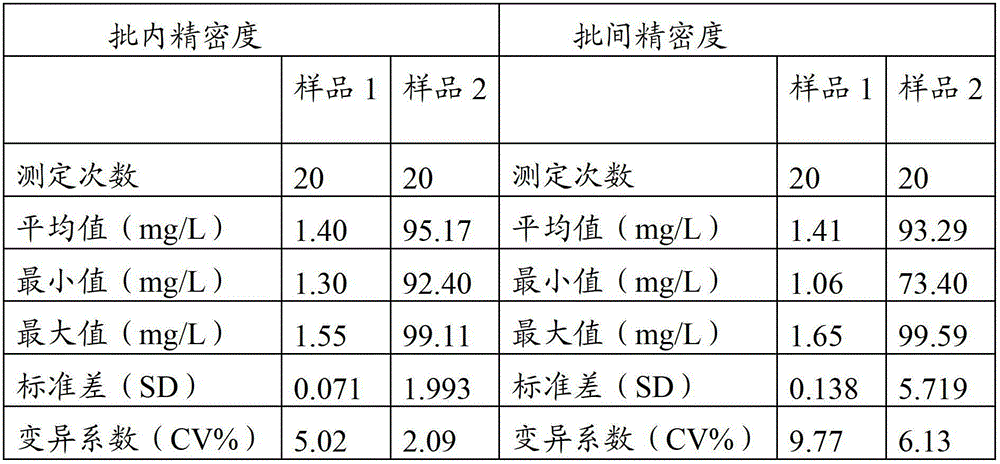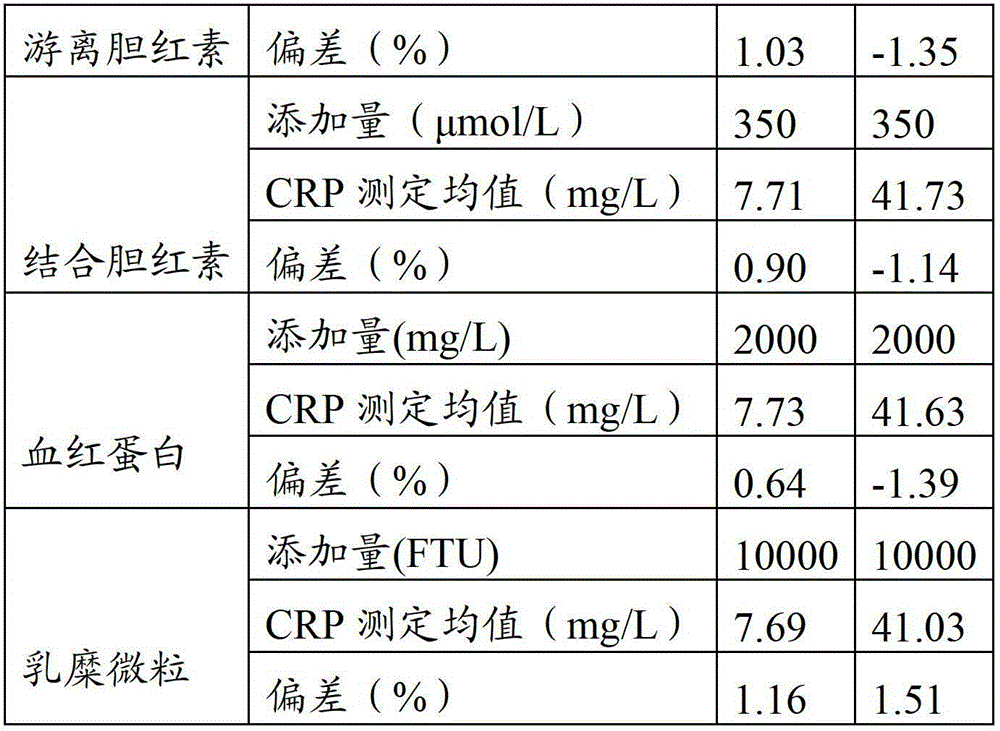Full-scale C-reactive protein (CRP) colloidal gold immunoturbidimetric assay kit
A technology for detecting kits and reactive proteins, which is applied in biological testing, material inspection products, etc. It can solve the problems of unfavorable cleaning of biochemical instruments, high manufacturing cost of latex, high price of latex-enhanced immune turbidimetric kits, and achieve great market competitiveness. , high sensitivity, easy to clean effect
- Summary
- Abstract
- Description
- Claims
- Application Information
AI Technical Summary
Problems solved by technology
Method used
Image
Examples
Embodiment 1
[0027] Kit preparation 1:
[0028] (1) The preparation of reagent R1 is as follows: add BSA with a final concentration of 0.5% (w / v) to 20mmol / L Tris buffer (pH7.5), and add BSA with a final concentration of 2% (w / v) PEG20000, NaN3 was added to a final concentration of 0.09% (w / v). Reagent R1 was thus prepared.
[0029] (2) The preparation of colloidal gold is as follows:
[0030] a) Cleaning of the glass container: Rinse it with tap water, then soak it with 1% to 2% hydrochloric acid overnight, take it out and rinse it with plenty of tap water, then wash it with detergent and rinse it with running water, then soak it with distilled water overnight, and then carry out colloid Jin Run wash.
[0031] b) Prepare 1% chloroauric acid and 1% sodium citrate solution, filter with 0.2um filter membrane.
[0032] c) Take a 1000ml round bottom flask, put it into the rotor, and add 500ml ultrapure water.
[0033] d) Add 5ml of 1% chloroauric acid, 600rpm, heat until the solution boil...
Embodiment 2
[0043] Kit preparation 2:
[0044] (1) Preparation of reagent R1
[0045] Add BSA at a final concentration of 2% (w / v) to 10 mmol / L citrate buffer (pH6.5), add PEG20000 at a final concentration of 0.5% (w / v), and add a final concentration of 0.09% ( w / v) NaN3. Thus the R1 reagent was prepared.
[0046] (2) Preparation of colloidal gold:
[0047] a) Cleaning of the glass container: Rinse it with tap water, then soak it with 1% to 2% hydrochloric acid overnight, take it out and rinse it with plenty of tap water, then wash it with detergent and rinse it with running water, then soak it with distilled water overnight, and then carry out colloid Jin Run wash.
[0048] b) Prepare 1% chloroauric acid and 1% sodium citrate solution, filter with 0.2um filter membrane.
[0049] c) Take a 1000ml round bottom flask, put it into the rotor, and add 500ml ultrapure water.
[0050] d) Add 5ml of 1% chloroauric acid, 600rpm, heat until the solution boils, immediately absorb 4ml of 1% sod...
Embodiment 3
[0060] Kit preparation 3
[0061] (1) Preparation of reagent R1
[0062] Add BSA at a final concentration of 1% (w / v) to 10 mmol / L phosphate buffer (pH6.5), add PEG20000 at a final concentration of 1% (w / v), and add a final concentration of 0.09% (w / v) / v) NaN3. Thus the R1 reagent was prepared.
[0063] (2) Preparation of colloidal gold:
[0064] a) Cleaning of the glass container: Rinse it with running water, then soak it with 1% to 2% hydrochloric acid overnight, take it out and rinse it with a large amount of tap water, then wash it with detergent and rinse it with running water, then soak it with distilled water overnight, and then carry out colloid Jin Run wash.
[0065] b) Prepare 1% chloroauric acid and 1% sodium citrate solution, filter with 0.2um filter membrane.
[0066] c) Take a 1000ml round bottom flask, put it into the rotor, and add 500ml ultrapure water.
[0067] d) Add 5ml of 1% chloroauric acid, 600rpm, heat until the solution boils, immediately absorb...
PUM
| Property | Measurement | Unit |
|---|---|---|
| Diameter | aaaaa | aaaaa |
| Sensitivity | aaaaa | aaaaa |
Abstract
Description
Claims
Application Information
 Login to View More
Login to View More - R&D
- Intellectual Property
- Life Sciences
- Materials
- Tech Scout
- Unparalleled Data Quality
- Higher Quality Content
- 60% Fewer Hallucinations
Browse by: Latest US Patents, China's latest patents, Technical Efficacy Thesaurus, Application Domain, Technology Topic, Popular Technical Reports.
© 2025 PatSnap. All rights reserved.Legal|Privacy policy|Modern Slavery Act Transparency Statement|Sitemap|About US| Contact US: help@patsnap.com



